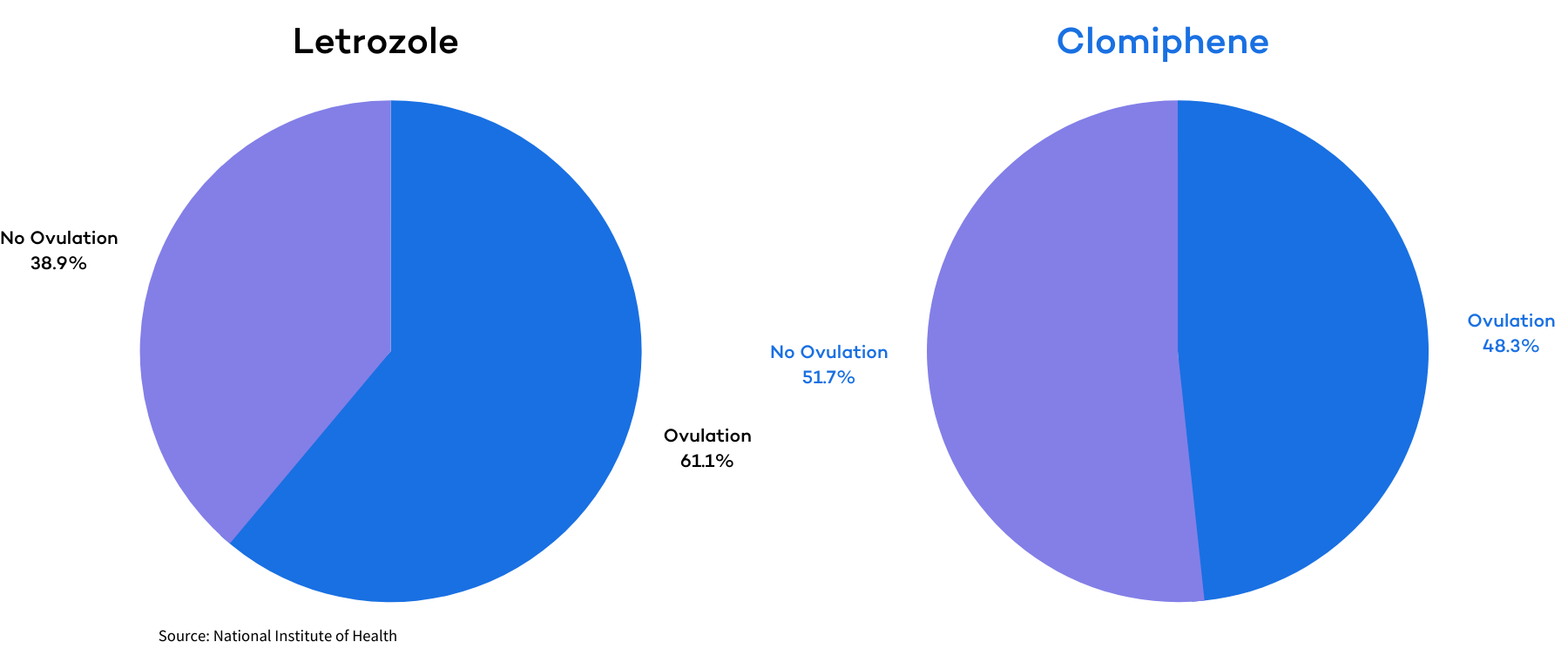Clomid vs Letrozole for Fertility

Clomid vs. Letrozole. It’s the battle for supreme first-line fertility treatment medications when trying to conceive isn’t going as easy as your junior high sex-ed class made it out to be.
Clomid (Clomiphene citrate) has been the most commonly prescribed oral fertility drug for over 50 years. Even today, it is commonly used as a first-line treatment to help women experiencing infertility, especially those with ovulatory issues like Polycystic Ovarian Syndrome (PCOS) or unexplained infertility.
Femara (Letrozole) was originally approved by the Food and Drug Administration (FDA) to be used as a breast cancer drug. Since 2001, fertility specialists have been prescribing it off-label to female patients with ovulatory infertility. It’s popularity amongst fertility specialists has been soaring ever since.
Ever since fertility specialists began prescribing Letrozole, there has been direct competition and constant research comparing the efficacy of the two medications to treat infertility. Here we will break down all of the latest research on Clomid vs Letrozole and provide an outlook on what medication reigns supreme in today’s fertility clinic.
Fast Facts
- Clomiphene and Letrozole both “lower” estrogen levels. When the body detects low estrogen levels, it makes more FSH and LH. High levels of FSH and LH drive follicular (egg) development and ovulation.
- Both medications increase the chances of ovulation and pregnancy substantially, particularly for those with ovulatory disorders.
- Both Clomid and Letrozole can be prescribed in conjunction with several reproductive treatments, including timed intercourse cycles, IUI, IVF, and mini-IVF.
- Most studies conclude that letrozole is slighly (if at all) more effective at inducing ovulation and helping achieve pregnancy.
- Most studies conclude that even if clomid is as effective at helping someone achieve pregnancy, letrozole is usually the better choice due to fewer side effects and risks.
- Letrozole can often be used for those who tried Clomid unsuccessfully and are considered “Clomid resistant.”
- Both medications are also used to treat male factor infertility cause by low testosterone.
What are Clomid (Clomiphene Citrate) and Letrozole (Femara)
Clomid and Letrozole are oral medications that help the ovaries to develop and ovulate high-quality eggs. Both medications achieve this by “lowering” estrogen levels in the body. The Hypothalamus in the brain interprets these low estrogen levels as a need to make FSH and LH. These hormones, particularly FSH, stimulate the development and release of the egg.
In short, both medications help to improve fertility in two main ways, (1) increasing the number of mature high-quality eggs that are developed each cycle and (2) inducing ovulation.
How Clomid and Letrozole Work
As mentioned, Clomid and Letrozole both exert their primary effect by “reducing” estrogen levels. Exactly how these medications go about “lowering” estrogen levels is the primary driver of their differences. While this may be a little sciency for some, it’s pretty cool. If it’s too much, feel free to skip to the next section.
Clomid Mechanism of Function
Clomid is a selective estrogen receptor modulator meaning it blocks estrogen receptors in the brain. By blocking estrogen receptors, the brain is tricked into believing there are low levels of estrogen which again, triggers the pituitary to make more FSH and LH. .
Clomiphene can take up to two weeks to clear out of the body (which is significantly longer than Letrozole). Clomiphene’s significant half-time for clearance causes a prolonged blocking of estrogen receptors and increased FSH/LH production for a significant length of time after the medication is stopped.
Clomid’s prolonged effects on FSH and estrogen production can cause more multiple follicle growth cycles when compared to natural and Letrozole cycles.
Letrozole Mechanism of Function
Letrozole is a nonsteroidal aromatase inhibitor that blocks estrogen synthesis from androgen precursors. Thus letrozole truly lowers estrogen levels in the body . Because less free-floating estrogen exists in the body, the brain detects these low levels and ramps up the production of FSH and LH.
Clomid vs. Letrozole for Inducing Ovulation
Ovulatory disorders are one of the most common causes of infertility. They affect about 30-40% of infertile women. Polycystic Ovarian Syndrome (PCOS) is the most common cause of anovulatory infertility and also the most common diagnosis of infertility in general.
Clomid has historically been used as the first-line fertility treatment for patients with PCOS or other ovulatory issues. However, recent research suggests that Letrozole may produce similar, if not better, results for inducing ovulation and producing live births for these patients.
In 2014, The National Institute of Health (NIH) published a study that measured the effectiveness of Letrozole and Clomid to treat PCOS patients’ infertility. During the study, 374 women received Letrozole treatment, and 376 women received Clomiphene treatment for five days starting on day three of their cycle for up to 5 cycles. The women in the Letrozole group had a cumulative ovulation rate of 61.7% (834 times in 1352 cycles). The women in the clomiphene group ovulated 48.3% of the time (688 times in 1425 cycles) . Other studies, have showed similar results.

However, the research isn’t so cut and dry. A study published in 2020 on anovulatory women with PCOS also compared the effectiveness of Letrozole and Clomid on inducing ovulation. Researchers found that both drugs produced similar ovulation rates, 86.7% for Letrozole and 85.2% for Clomid. However, they still concluded that Letrozole is a better alternative for ovulation induction in anovulatory women with PCOS because it produced higher pregnancy rates, shorter time to pregnancy, and lower chances of multiple pregnancies due to higher instances of mono-follicular growth .
Clomid Resistance
Clomid can help induce ovulation in many patients, but it doesn’t quite do the trick for some. If patients don’t ovulate after Clomid treatment, their doctor may increase the dosage. If increasing the dosage doesn’t work, patients are considered Clomid resistant.
Patients may be Clomid resistant for several different reasons. Patients with a body mass index (BMI) of over 25 have a decreased chance of Clomid working. Patients with hyperprolactinemia (high levels of prolactin in the blood) also may not respond well to Clomid . Women with PCOS are the most common to experience Clomid resistance, especially those who are diagnosed with insulin resistance or with hyperandrogenic levels .
Research has shown that Letrozole can help to induce ovulation for some women who have previously failed with Clomid or are considered “Clomid Resistant.” In one study, Letrozole significantly improved ovulation rates and live birth rates for women who failed to ovulate with Clomid treatment .
Clomid vs. Letrozole Pregnancy & Live Birth Rates – PCOS
In the 2014 NIH study mentioned above, Letrozole was more effective at inducing ovulation for patients with Polycystic Ovarian Syndrome (PCOS). In that same study, researchers also measured Clomid and Letrozole’s effect on live birth rates. Of the 374 women treated with Letrozole, 103 (27.5%) had a live birth. Of the 376 women treated with Clomiphene, only 72 (19.1%) of the women had a live birth. .

In another study, researchers compared the effects of Letrozole and Clomiphene as first-line ovulation induction drugs to treat infertile PCOS women. They split 103 infertile women with PCOS into Clomiphene and Letrozole treatment groups. The patients treated with Letrozole experienced a pregnancy rate nearly three times that of the Clomiphene group. The pregnancy rates were 21.56% for the Letrozole group and 7.84% for the Clomiphene group .
Clomid vs. Letrozole Pregnancy & Live Birth Rates – Unexplained Infertility
Both Clomid and Letrozole can help women with unexplained infertility to achieve pregnancy. A clear verdict isn’t out on exactly which treatment is more effective. Conflicting studies exist supporting the efficacy of both Clomid and Letrozole to improve pregnancy and live birth rates in women with unexplained infertility. In most studies, Clomiphene and Letrozole treatment produce statistically similar results.
Based on the results of the 2014 National Institue of Health (NIH) study which showed that Letrozole was more effective than Clomiphene for achieving live births in women with PCOS, the NIH decided to compare both medication’s ability to treat unexplained infertility. One of the studies they reviewed was published in the NEJM in 2015. The study compared the effects of Clomiphene and Letrozole on patients with unexplained infertility who underwent timed intrauterine inseminations for up to 4 monthly menstrual cycles or until they became pregnant or discontinued treatment. During the study, 35% of the Clomiphene group and 28% of the Letrozole group had a positive pregnancy test.

There was a statistically significant difference between pregnancy rates, but the live birth rates were similar. 23% of the Clomiphene group achieved live births compared to 19% for the Letrozole group. The live birth rates were slightly lower in the women who took Letrozole, but the results were considered statistically similar by researchers. Researchers concluded that Clomiphene is at least as successful as Letrozole for treating patients with unexplained infertility .
In another study, researchers also compared the efficacy of Clomiphene and Letrozole to treatment on women with unexplained infertility. The results of the randomized control trial indicated that Letrozole may improve implantation and pregnancy rates in women with unexplained infertility. More than double the percentage of women treated with Letrozole achieved pregnancy (23.07%) compared to the group treated with Clomiphene (10.7%) .

In addition to the higher pregnancy rate, the group treated with Letrozole also saw a statistically significant improvement in endometrial receptivity. Researchers concluded that Letrozole has a beneficial effect on the endometrium when compared to Clomiphene, which may improve implantation and pregnancy rates in women with unexplained infertility .
In 2019, researchers conducted a systematic review and meta-analysis of data on pregnancy and live birth rates from past studies comparing the effectiveness of Clomid and Letrozole to treat unexplained infertility. In the analysis of eight randomized controlled trials, 24% of patients treated with Letrozole and 23% of patients treated with Clomiphene tested positive as pregnant. The was no significant difference in positive pregnancy test rates or live birth rates between patients treated with Letrozole or Clomiphene citrate.

Researchers concluded that there is no significant statistical difference in the effectiveness of Clomid or Letrozole to improve clinical outcomes for patients with unexplained infertility .
Differences in Side Effects That Impact Fertility
One of the main reasons that fertility doctors have started prescribing Letrozole to patients with fertility issues is because it has fewer side effects than Clomiphene. Clomiphene can cause a thinner endometrial lining and a higher instance of multiple pregnancies in some patients.
Their difference in mechanism of function and how long they remain effective in the body likely cause the difference between Clomid and Letrozole’s side effects.
Endometrial Thinning
Some women may have a thin uterine lining (endometrium) during Clomid treatment cycles. A thin uterine lining makes it more difficult for an embryo to implant and thus more difficult to achieve pregnancy. Researchers believe the endometrial thinning associated with Clomid is a result of Clomid’s prolonged effect on estrogen receptors in the uterus. During a natural menstrual cycle, estrogen stimulates the development of the endometrium, causing it to thicken. Because Clomid blocks estrogen receptors in the brain as well as those in the uterus/endometrium, the uterine lining does not thicken as it should.
Since Letrozole also lowers estrogen levels, one would assume it would also negatively affect endometrial thickness. However, studies have shown that endometrial thickening is higher in patients treated with Letrozole when compared to those treated with Clomiphene. This is likely due to the fact that Letrozole is cleared more quickly from the body allowing the uterine lining enough time to thicken.
Multiple Pregnancies
Both Letrozole and Clomid can cause multiple eggs to be ovulated, but research indicates that Letrozole results in more mono-follicular cycles . Mono-follicular cycles lead to singular pregnancies (rather than twins and triplets) and are thus much safer for both mom and baby.

Why does Letrozole lead to fewer multiple pregnancies? As previously mentioned, Letrozole has a much shorter half-life when compared to Clomid. During a Letrozole cycle, as one dominant follicle grows it secrets more and more estrogen that can not be blocked by aromatase inhibiting effects of Letrozole. This causes the suppression of FSH and smaller growing follicles to stop developing. In most women, a single dominant follicle fully develops and mono-ovulation occurs . In a Clomid cycle, FSH production is not suppressed by the rising levels of estrogen as the estrogen receptors remain blocked due to two week “half life” of clomid. The constant and high levels of FSH during a Clomid cycle often cause multiple follicles to reach maturity and ovulate .
Cost Comparison
Clomid and Letrozole are both commonly covered by insurance at equal rates. They also cost similar amounts at most pharmacies if they are not covered by insurance. On Good RX, Letrozole can be found as inexpensive as $20.50, and Clomiphene can be found as low as $23.00
In Conclusion
Clomid and Letrozole are extremely useful and trusted fertility medications. They both help to induce ovulation and increase egg production at a much more affordable price point than injectable medications like gonadotropins. Similarly, they can both be used in conjunction with several different fertility treatments to improve the chances of getting pregnant.
Although conflicting results do exist, Letrozole appears to be the more effective medication to induce ovulation and increase pregnancy rates, especially for patients with PCOS. Many fertility specialists also prefer Letrozole because it causes fewer side effects.
Before taking any new medications, be sure to consult with your doctor. Scheduling a consultation with one of our fertility specialists can help to determine which treatment is most likely to improve the chances of you growing your family.





